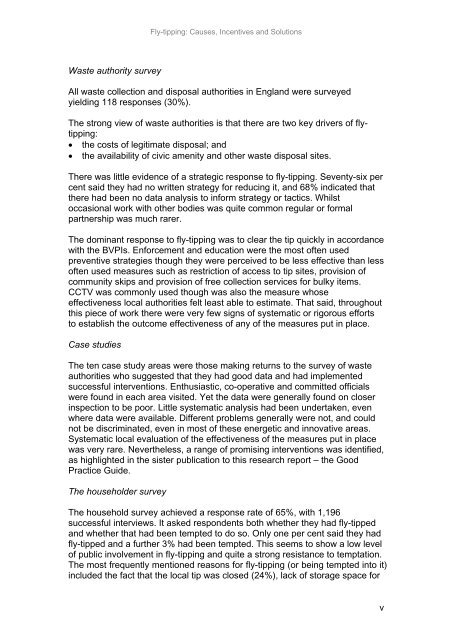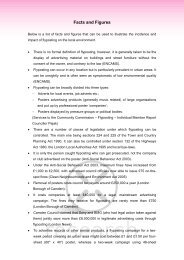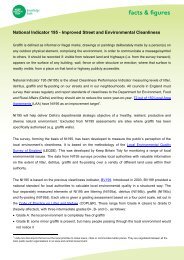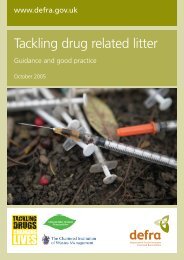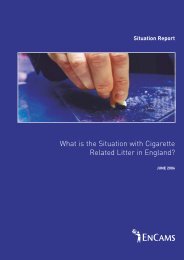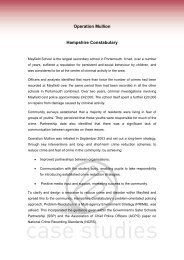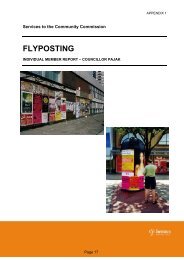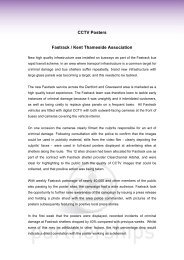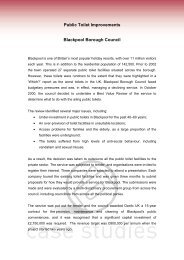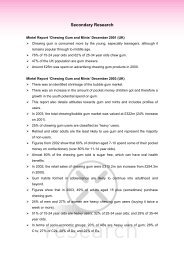Fly-tipping: Causes, Incentives and Solutions - Keep Britain Tidy
Fly-tipping: Causes, Incentives and Solutions - Keep Britain Tidy
Fly-tipping: Causes, Incentives and Solutions - Keep Britain Tidy
Create successful ePaper yourself
Turn your PDF publications into a flip-book with our unique Google optimized e-Paper software.
<strong>Fly</strong>-<strong>tipping</strong>: <strong>Causes</strong>, <strong>Incentives</strong> <strong>and</strong> <strong>Solutions</strong><br />
Waste authority survey<br />
All waste collection <strong>and</strong> disposal authorities in Engl<strong>and</strong> were surveyed<br />
yielding 118 responses (30%).<br />
The strong view of waste authorities is that there are two key drivers of fly<strong>tipping</strong>:<br />
• the costs of legitimate disposal; <strong>and</strong><br />
• the availability of civic amenity <strong>and</strong> other waste disposal sites.<br />
There was little evidence of a strategic response to fly-<strong>tipping</strong>. Seventy-six per<br />
cent said they had no written strategy for reducing it, <strong>and</strong> 68% indicated that<br />
there had been no data analysis to inform strategy or tactics. Whilst<br />
occasional work with other bodies was quite common regular or formal<br />
partnership was much rarer.<br />
The dominant response to fly-<strong>tipping</strong> was to clear the tip quickly in accordance<br />
with the BVPIs. Enforcement <strong>and</strong> education were the most often used<br />
preventive strategies though they were perceived to be less effective than less<br />
often used measures such as restriction of access to tip sites, provision of<br />
community skips <strong>and</strong> provision of free collection services for bulky items.<br />
CCTV was commonly used though was also the measure whose<br />
effectiveness local authorities felt least able to estimate. That said, throughout<br />
this piece of work there were very few signs of systematic or rigorous efforts<br />
to establish the outcome effectiveness of any of the measures put in place.<br />
Case studies<br />
The ten case study areas were those making returns to the survey of waste<br />
authorities who suggested that they had good data <strong>and</strong> had implemented<br />
successful interventions. Enthusiastic, co-operative <strong>and</strong> committed officials<br />
were found in each area visited. Yet the data were generally found on closer<br />
inspection to be poor. Little systematic analysis had been undertaken, even<br />
where data were available. Different problems generally were not, <strong>and</strong> could<br />
not be discriminated, even in most of these energetic <strong>and</strong> innovative areas.<br />
Systematic local evaluation of the effectiveness of the measures put in place<br />
was very rare. Nevertheless, a range of promising interventions was identified,<br />
as highlighted in the sister publication to this research report – the Good<br />
Practice Guide.<br />
The householder survey<br />
The household survey achieved a response rate of 65%, with 1,196<br />
successful interviews. It asked respondents both whether they had fly-tipped<br />
<strong>and</strong> whether that had been tempted to do so. Only one per cent said they had<br />
fly-tipped <strong>and</strong> a further 3% had been tempted. This seems to show a low level<br />
of public involvement in fly-<strong>tipping</strong> <strong>and</strong> quite a strong resistance to temptation.<br />
The most frequently mentioned reasons for fly-<strong>tipping</strong> (or being tempted into it)<br />
included the fact that the local tip was closed (24%), lack of storage space for<br />
v


